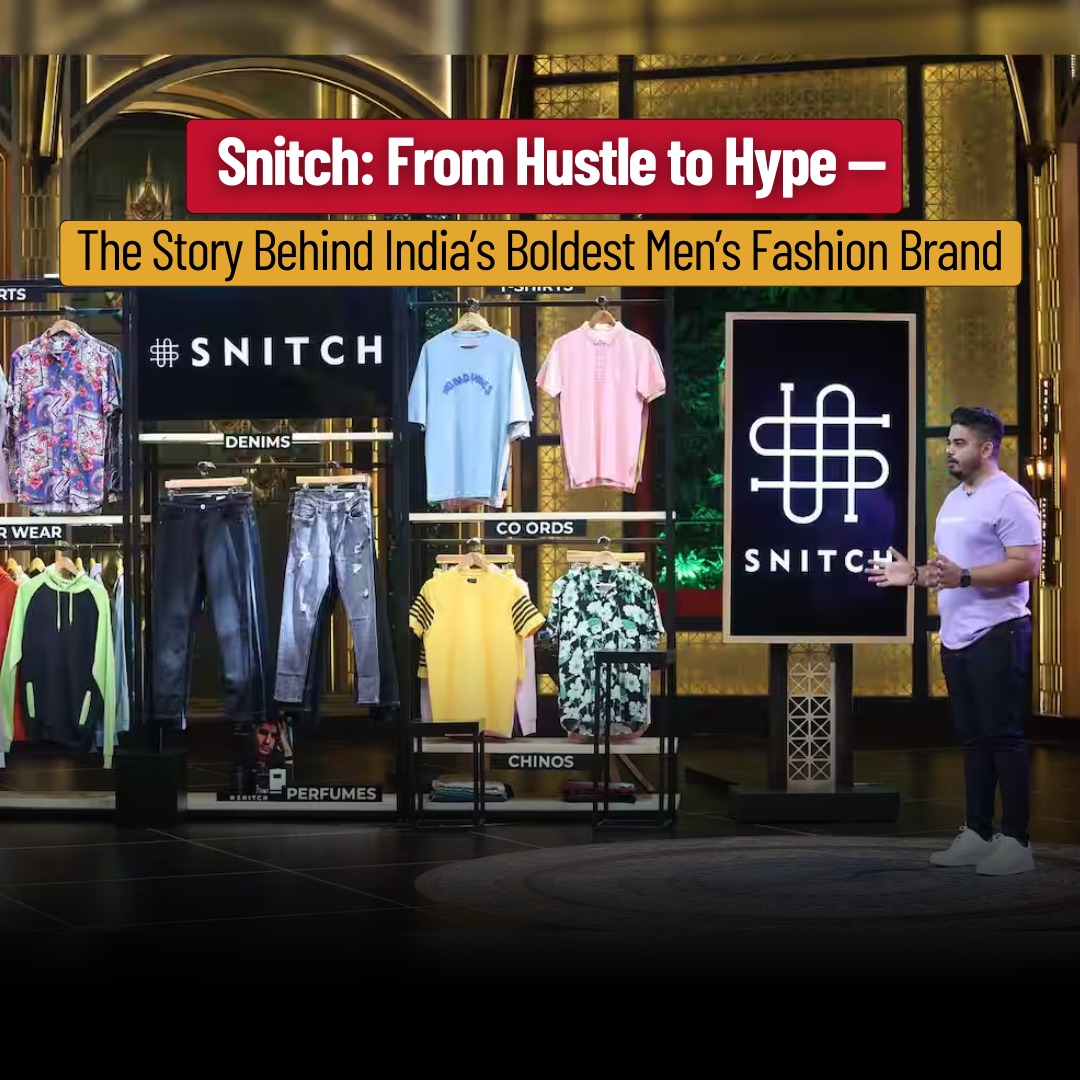“No Gold, Just Grit” How a Teenager’s Side Hustle Became a ₹500 Crore Brand
“No IIT, no IIM, no fancy MBA just a B.Com degree and a burning passion for fashion…” Siddharth Dungarwal, Founder, Snitch
What happens when a teenager obsessed with fabric spots a vacant shop next to his father’s jewellery store? A revolution begins. Siddharth Dungarwal started selling leftover factory cloth as a teenager. That spark turned into Snitch a trailblazing men’s fashion label redefining Indian style.
The Style Gap No One Was Filling
“I couldn’t find clothes that matched my vibe. Everything felt either too boring or too loud.”
If you’ve ever felt this while scrolling through racks in a mall or browsing endlessly online, you’re not alone. In fact, that exact frustration is what sparked the idea behind one of India’s most talked-about fashion brands for men Snitch.
Every man has been there. Staring at a wardrobe filled with basics nothing exciting, nothing expressive, nothing that feels you. For years, Indian menswear lagged behind. The choices were safe, the fits were generic, and the styles… uninspiring. Fast fashion was accessible globally, but in India? Men had few options that were both stylish and affordable. That frustration wasn’t just felt by consumers — it sparked the beginning of one of India’s fastest-growing fashion brands: Snitch.
Bootstrapped Beginnings: No Degree, Just Drive
In 2009, at just 15, Siddharth began learning the ropes of business at his family’s jewellery store in Bangalore. But his true passion was fashion. With ₹2.5 lakh and a bankrupt fabric supplier’s stock, he got creative. After sending swatches to a Mumbai retailer and selling ₹150,000–₹160,000 in his first weekend, he knew he was onto something. From there, it was relentless execution prototypes, shirt production, retailer sales — scaling a ₹2–3 lakh hustle into a ₹50–60 crore annual run-rate business. His B2B approach, focused on fast-fashion drops, caught fire among retailers. Then came 2020 and everything changed.
The Pivot to D2C: Reinventing Amid Crisis (2020)
When the pandemic struck in 2020, the fashion industry was brought to its knees physical stores closed overnight, supply chains froze, and unsold stock gathered dust. For Snitch, which had built its momentum through a successful B2B model supplying trending menswear to retailers, it could have meant collapse. Instead, it marked a reinvention.
In July 2020, Snitch launched its own Direct-to-Consumer (D2C) website a strategic leap into a new chapter. The mission was clear: bypass the middlemen, speak directly to customers, and take end-to-end control of the brand experience, from concept to closet. But this shift wasn’t just about changing distribution channels. It demanded a complete rethinking of how fashion should move in a digital-first world with speed, data, and customer obsession at its core.
Snitch’s D2C playbook was built around three key pillars:
• Fast Fashion Meets Fast Feedback: New styles were launched in micro-batches of just 50–100 units. Real-time metrics tracked performance, triggering restocks for hits and killing off underperformers keeping inventory lean and designs relevant.
• Digital-First DNA: With physical retail on pause, Snitch doubled down on Instagram, influencer campaigns, and visually-driven storytelling to build a fashion identity tuned to the scroll-happy Gen Z and millennial crowd.
• Consistency with Surprise: The brand married wearable basics with bold twists clean silhouettes, statement co-ords, contemporary prints, and edgy cuts that made fashion feel fresh without overwhelming the everyday dresser.
The Results: Reinvention That Redefined Growth
In less than three years, what started as a tactical shift became a transformative growth story:
• 5 lakh+ app downloads
• 2.5%–2.8% conversion rate significantly above the industry average
• ₹1,700 average order value
• ₹500+ crore annual revenue run rate
Snitch didn’t just survive the pandemic it reshaped its identity, reinvented its model, and redefined the rules of modern retail. As others pulled back, Siddharth Dungarwal and his team doubled down not only sailing through the storm but building a faster, smarter ship in the process.
The Meteoric Rise: Strategy in Motion
After its bold pivot to D2C in 2020, Snitch didn’t just grow it exploded. What followed was a series of sharp, intentional moves that catapulted the brand from a niche startup to a ₹500+ crore fashion powerhouse.
Fast Fashion Meets D2C: The Drop Model That Clicked
Inspired by global fast-fashion giants like Zara and H&M, Snitch adopted the “drop model” — a strategy where limited-edition collections are launched frequently, often every 7 to 10 days. This constant churn of fresh styles tapped directly into the psyche of India’s Gen Z and millennial shoppers, especially those scrolling endlessly on Instagram and fashion reels.
But unlike global giants, Snitch made it uniquely Indian:
• It localized the fits, fabrics, and colors to suit Indian tastes and climates.
• It produced in small, controlled batches (50–100 units), using real-time demand to restock only what was working reducing wastage and maximizing trend alignment.
• Every drop was Instagram-ready: bold prints, co-ords, edgy streetwear, and stylized basics — all with an affordable mass-premium price tag.
This model created urgency and ‘FOMO’, encouraging repeat visits and faster conversions, a hallmark of high-performing D2C brands. “We are like the fashion gossip guys,” Siddharth quipped. “Snitching on trends before anyone else does.”
Prime Time Moment: Shark Tank India Breakthrough
Snitch’s appearance on Shark Tank India Season 2 was a turning point not just in funding, but in perception. The pitch was clean, confident, and backed by numbers. Siddharth walked away with ₹1.5 crore for 1.5% equity — a rare deal where all five sharks came on board.
But the funding wasn’t the real win. The credibility and brand trust that came with it was equivalent to what Siddharth estimates as an ₹8 crore marketing boost. Overnight, Snitch became a household name. The Shark Tank exposure validated the brand in the eyes of lakhs of new customers who now associated it with ambition, quality, and innovation.
Omnichannel Expansion: Bridging Digital with Physical
While Snitch was born online, it never stayed limited to the web. Recognizing that many Indian shoppers still value the touch-and-feel experience, Snitch began building offline stores across key metro cities. Today, offline retail contributes nearly 50% of overall sales, acting as both a revenue driver and a trust builder for first-time customers. But this move wasn’t a retreat from tech it was a complement to it.
The brand’s app-first approach also paid dividends:
• Over 2 million app downloads
• App contributes 70%+ of online revenue
• Personalized experiences powered by consumer behavior data
• Predictive triggers that decide which styles to restock based on how products perform within the first few hours of launch
In essence, Snitch built a feedback loop where data shapes design, and design drives demand both online and offline.
What The Future Holds
• Potential IPO: Snitch is aiming for an IPO, but will begin preparations after reaching a profit of INR 100 Cr.
• Global expansion: They are considering a pilot program in the Middle East by December 2025.
• Technology upgrades: Snitch is working on improving their tech, including a return management system and a loyalty program, according to ET Retail.
The Final Stitch: Fashioned for the Future
What started as a mere aspiration triggered by a vacant shop nearby, lead to setting up the most adaptable production channels. Snitch’s journey has multiple insights in store for how to invest in an idea the best way possible. Currently, they’re dominating India’s men’s fashion scene with an amazing strategy focusing on retention rate, trend adaptability along with increasing their availability both online and offline. They’re on a bright path of hustle ahead with plans of expanding globally, issuing IPO and upgrading their technology. With all that said, it is evident that this brand will soon be a household name globally.
- The Making of a Malkin: The Inspiring Tale of Nish Hair
- Snitch: From Hustle to Hype — The Story Behind India’s Boldest Men’s Fashion Brand
- STARTING A HANDMADE CRAFTS BUSINESS IN CHIANG MAI
- SUGAR COSMETICS: BEAUTY FOR EVERY SHADE OF INDIA
- From Mandaps to Mobile Apps: How Shaadi.com Redefined India’s Marriage Industry
Alopecia support India artisan business beauty industry India Beauty with purpose brand storytelling Cancer hair recovery Chiang Mai Chiang Mai crafts market Clip-in hair extensions craft entrepreneurship cultural business D2C brands D2C brands India D2C crafts Thailand Direct-to-consumer brand India diversity in beauty Empowerment through beauty foreign business license Thailand Hair loss solutions India Hair toppers for women handmade crafts handmade export inclusive beauty Indian fashion brands Indian startup influencer marketing India Instagram marketing India local artisans Malkin entrepreneur men’s fashion India Natural human hair extensions Organic brand growth Postpartum hair loss help Shark Tank India Shark Tank India brands Siddharth Dungarwal Snitch clothing brand Snitch India starting a business in Thailand startup success story sustainable crafts Thai handicrafts Thai visa for business women-led startups women empowerment
Snitch’s journey from a teenager’s side hustle to a ₹500 crore fashion powerhouse is a masterclass in bold branding, fast fashion, and digital-first strategy — as seen on Shark Tank India.






